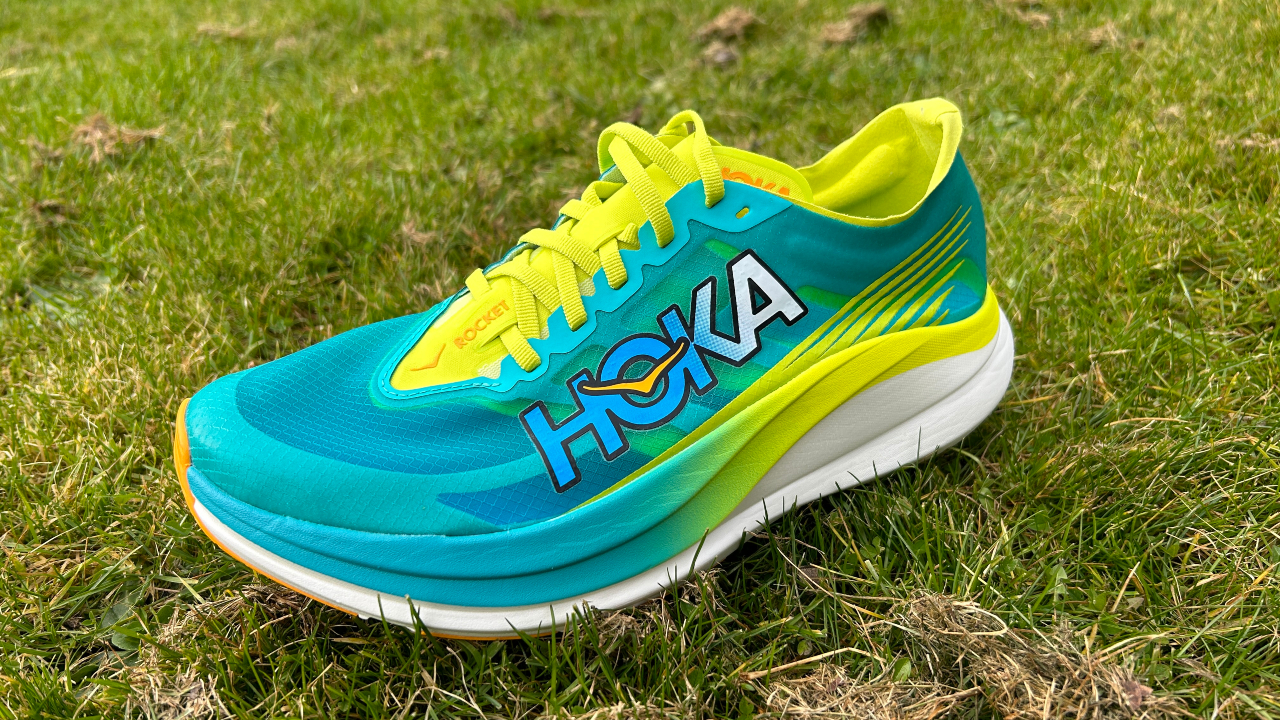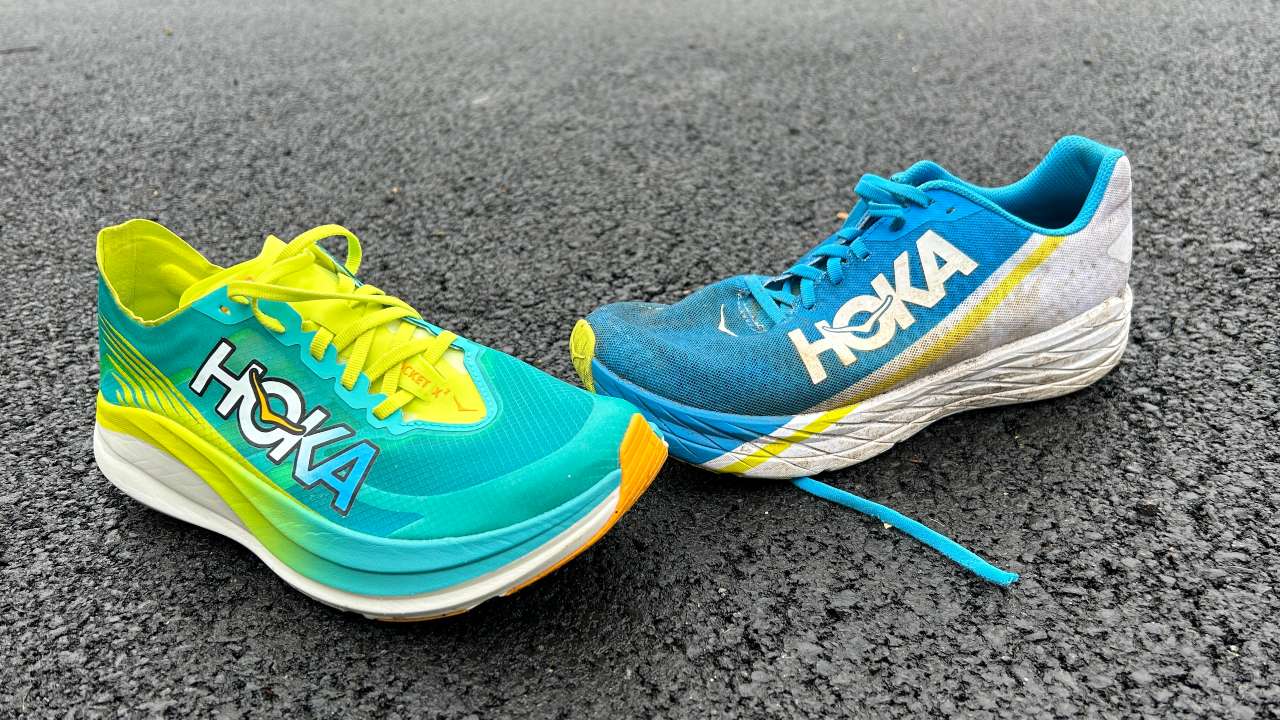Our Verdict
The Hoka Rocket X 2 is the best racing shoe Hoka has made and it’s a great new carbon option for those who prefer low-drop racing shoes. I still rate other carbon shoes ahead of it, though, especially for long events such as the marathon.
For
- Soft and springy midsole
- Lighter than Rocket X
- More nimble than other carbon shoes
Against
- Low drop won’t suit everyone
- Not as much cushioning as others
- Concerns over heel rub
You can trust Coach
Hoka was among the first brands to join the carbon shoe revolution – its Carbon X came out not long after the Nike Vaporfly. However, it’s never really had a shoe that’s met the standard of the best carbon plate running shoes. The Carbon X and Rocket X are solid trainer/racers, but heavier and less propulsive than their rivals. The Hoka Rocket X 2 is a different animal, with a PEBA-based midsole that provides the soft and springy ride you expect from a super-shoe. It’s Hoka’s best racing shoe by a mile.
Hoka Rocket X 2: Price And Availability
The Hoka Rocket X 2 will launch on 16 March 2023 and costs $250 in the US and £220 in the UK. This means it’s Hoka’s most expensive carbon shoe – the original Rocket X cost $200/£140 and the Carbon X3 $200/£170 – though it is in line with the price of super-shoes from other brands.
Design And Fit
The most important update to the Hoka Rocket X 2 is the new midsole, which is now made from a PEBA-based foam rather than the EVA Hoka has previously used on its carbon shoes. The shoe has a dual-density midsole, with a softer layer of foam on top of the full-length scooped carbon plate, and a slightly firmer layer beneath.
This midsole is softer, bouncier and lighter than the foams used on the Rocket X and Carbon X3. The Hoka Rocket X 2 weighs 7.9oz/225g in my UK size 9, which is an increase on the 7.6oz/217g the original Rocket weighs in my size, but the new shoe’s stack has also increased by 6mm in height. The Rocket X 2 is 36mm high at the heel and 31mm at the forefoot for a 5mm drop.

The upper is made from a lightweight synthetic mesh with additional structure added at the midfoot and around the front of the shoe. There is no heel counter and minimal padding around the heel and on the gusseted tongue, the aim being to keep the upper as light as possible. In my normal size the Rocket X 2 fitted well, with regards to length, and though I had problems with heel rub, I think sticking with your normal running shoe size is the best option.
There is a substantial cut-out in the midsole – now par for the course with carbon shoes – that allows you to see the carbon plate from underneath. The outsole has rubber on the forefoot, along with two strips at the back of the shoe to provide grip and durability in heavy-use zones, with exposed foam around the cut-out in the midfoot.
How I Tested This Shoe

I’ve completed four runs in the Hoka Rocket X 2 ahead of its launch: a short interval session on the road and one on the track, a longer session that included a parkrun, and a 16km run with a 10km stint at marathon effort. I have also tested every generation of the Hoka Carbon X, the Rocket X, and most of the best carbon plate running shoes on the market.
Sign up for workout ideas, training advice, reviews of the latest gear and more.
Running Performance
When you start running in the Rocket X 2 it’s obvious that it’s different from Hoka’s previous carbon shoes. It’s softer and bouncier than the Rocket X and Carbon X3, and feels more akin to super-shoes from other brands than anything Hoka has produced before.
The ride is excessively soft at slower paces – in fact it’s so squishy the transition is a little slow. Once I started running fast in the Rocket X 2 it firmed up underfoot and felt snappy, moving me onto my toes quickly.
I took it to the track to run 8 x 400m reps at fairly controlled paces with short 100m jog recoveries, and the Rocket X 2 felt fantastic. Running the reps felt like a cruise and when I picked up the last rep to run all-out, the shoe felt light and nimble.
The combination of its lower stack and drop compared with most other super-shoes also makes the Rocket X 2 feel more natural underfoot. It’s not exactly stable, since the foam is so soft, but you can attack corners on the road more aggressively than in higher shoes like the Nike Alphafly NEXT% 2 or Mizuno Wave Rebellion Pro.

I used it for a parkrun next, first running a steady 5K at around 3min 40sec/km pace and then going all out on the parkrun and logging 16min 43sec. I still enjoyed the Rocket X 2 on this, but a couple of concerns crept in.
One was heel rub. My left foot was raw by the end of the run. Since then I’ve heel-locked the left shoe and bandaged my heel to protect it when using the Rocket X 2, which has made it fine to use, but it’s still something to be wary of.
Also, late in the parkrun when I was tiring and rocking back more on my heels, I didn’t feel the shoe was rocking me forwards as effectively as higher-drop, firmer super-shoes like the Vaporfly or the New Balance Fuelcell SC Elite V3 – the latter has a lower drop than the Hoka but also has a firmer midsole and an aggressive rocker, so the drop feels higher to me.
On my most recent run in the shoe – 16km, with 10km steady at around marathon effort – I felt that the Rocket X 2 lacked the propulsion you get from shoes that hit the 40mm limit. The Hoka felt good in the 10km steady, when I was running fast but within myself and getting a smooth transition, but by the end of the run it seemed to lose a bit of bounce – as if the soft midsole had compressed during the run and lost some of its rebound.
Higher shoes with firmer foams, like the Alphafly 2 or Asics Metaspeed Sky+, retain their bounce further into runs, so it would be a concern for me if I was looking to do a marathon in the Rocket X 2.
Is The Hoka Rocket X 2 Worth It?

The Rocket X 2 is a great carbon shoe and the best racing shoe Hoka has made. I enjoyed running in it, and any concerns I have about its performance are minor. However, minor concerns are all that really separates the best carbon plate running shoes, and I’d probably reach for a few others ahead of the Rocket X 2 on race day.
There are shoes with more bounce in the midsole, like the Nike Alphafly NEXT% 2, Mizuno Wave Rebellion Pro and Adidas Adizero Adios Pro 3, and shoes that have a more aggressive feel that keep you rolling late into races, like the Nike Vaporfly NEXT% 2 or New Balance Fuelcell SC Elite V3.
Where the Hoka Rocket X 2 stands out to some degree is its low drop. That said, the Asics Metaspeed Sky+ has a similar drop, though with a bouncier foam for long-distance events.
In my opinion, you wouldn’t be disappointed if you picked up the Hoka Rocket X. It’s a great option for races of any distance, though for me it would work best for 5K to half marathon. I just think in the highly competitive world of carbon shoes, I have enough concerns about the Rocket X 2 that I’d pick out a different shoe.

Nick Harris-Fry is a journalist who has been covering health and fitness since 2015. Nick is an avid runner, covering 70-110km a week, which gives him ample opportunity to test a wide range of running shoes and running gear. He is also the chief tester for fitness trackers and running watches, treadmills and exercise bikes, and workout headphones.

